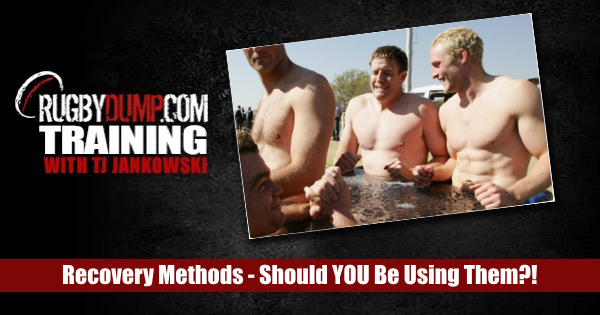
In today’s post Rubydump Academy Coach TJ discusses recovery, specifically the 4 most popular methods of recovery and whether you should be using them in your routine. If you want to get the most out of your training without feeling sore all the time, then read ahead!
Pre-season is an incredibly important time of the rugby season. You and your team train really hard to get the most benefit – fitter, faster, stronger, better.
You’re probably going to make the most amount of progress during this time of the year. There’s actually a good chance you’re going to be suffering for a decent part of it too. “No pain, no gain” right?
It’s also here where many lads decide to start trying to use a tonne of different things to help them with recovery. It’s also where people get confused about exactly what they should be doing. So here I am to try and clear that up for you.
Sleep
This is so obvious, yet so under-utilised. It’s the time where your body does the most recovery all by itself. Basically there is no use in messing around with any other recovery method if you aren’t getting your sleep right. 8 hours is often the time thats recommended, but everyone is different, some need more, some less.
It’s important to note that over-sleeping is going to impact your training also, because it can leave you drowsy and not performing at your best.
However, there is new research indicating that regular longer sleep may be of significant benefit to athletes. If anything becomes more conclusive I’ll start recommending it but for now, just regular 7-8 hours will do wonders.
Food
Hold the protein shakes! As written about before (check out rugby nutrition here), many rugby lads actually consume too much protein on a daily basis.
This isn’t necessarily a bad thing, but if you only ate the necessary amount of protein (around 2g per kg of bodyweight) and switched the leftover amount of protein to carbs, you’re giving yourself a much better chance of recovering and making gains. Not just with muscle growth, but with all aspects of strength and conditioning.
It’s also important to note that when working on your conditioning during pre-season, you should not be cutting carbs to boost your weight loss. Carbs give you the energy to train well which is what is going to have the biggest impact on your improvements that you’ll make.
Ice Baths / Cold Therapy
This is where recovery starts to get specific. Ice baths / cold therapy is great at the right time of the year, but use it at the wrong time and you will be missing out on some crucial improvements.
This is essentially because the process that the body goes through to recovery is the same process that allows your body to adapt and improve. Speeding up this process with cold therapy will skip out a lot of these adaptations, meaning training won’t benefit you as much as it could’ve.
In-season that is fine and necessary, you don’t want to be going into games sore! It’s more important to keep fresh than it is to adapt.
In the off-season and pre-season, you should put up with some extra soreness for a little longer, because then you’re going to experience the full benefit of the training that you’re doing!
Stretching
Many people see stretching as a method for recovery, but this is a misinterpretation of the benefits of stretching. Stretching after training is going to definitely cool down your muscles properly, this will help you in your battle against soreness, although it won’t actually prevent it.
Stretching also obviously comes in handy because flexibility and mobility can really help reduce your injury risk.
What stretching won’t do is relieve any soreness straight away, particularly if you stretch a cold muscle. There seems to be a trend of mobility sessions to increase recovery.
The problem with this idea is that performing mobility work and doing things such as yoga don’t replenish your recovery ability, they actually deplete it! This means that now not only do you have to recover from your regular training, but your mobility sessions too!
Now this is isn’t to say that you should do away with mobility work and stretching altogether, but use it as you need it. As Dr James Hoffman said on the interview I did for the Rugbydump Academy, “You should be as flexible as you need to be for your sport. Performing excessive mobility and stretching work is time wasted that could be spent working on skills and other things that will have a direct effect on making you better at rugby”.
If you want to hear this interview in full and get access to training programmes designed specifically for rugby players’ different goals then click here and check out the Rugbydump Academy. We’re so convinced you’ll love it that you can try it out for just $1!
As always, if you have any questions on anything I’ve discussed above, I’d love to hear from you in the comments below.
About TJ JankowskiTJ Jankowski is a former international rugby player for Poland rugby, who achieved their highest world ranking of 23 whilst he was part of the team. Priding himself on a system of coaching and creating plans for people in the real world, not robots, TJ has worked with international rugby players from 4 different continents and we are thrilled to announce that he can help you as part of the Rugbydump Academy. |
|

Sign In